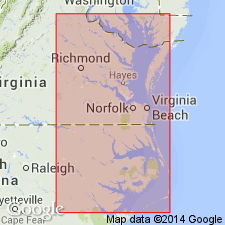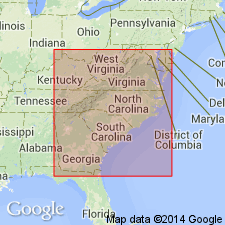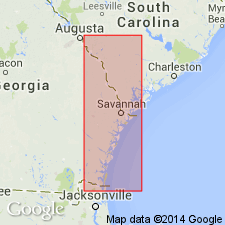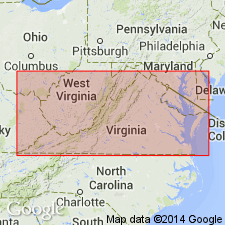
- Usage in publication:
-
- Sunken Meadow Member*
- Modifications:
-
- Named
- Dominant lithology:
-
- Sand
- AAPG geologic province:
-
- Atlantic Coast basin
Summary:
Named as member of Yorktown Formation. Named for Sunken Meadow Creek, Surry Co., eastern VA. Occurs in eastern to southeastern VA, including the southern tip of Delmarva Peninsula, and in northeastern NC. Consists of a basal, transgressive, coarse to medium, poorly sorted, very shelly sand. Basal lag deposit marks lower contact to the west; to the east, basal deposits are finer with more glauconitic and phosphatic, fine shelly sand. Thickness averages 3 m, but thins to the west and pinches out. Unconformably overlies Cobham Bay Member (new) of Eastover Formation in much of VA and older sediments farther south. Although upper contact with Rushmere Member appears to be conformable, there is evidence of a brief diastem. Report includes generalized geologic map, correlation chart and list of fossils (too numerous to list here, but all are mollusks). Age is early Pliocene.
Source: GNU records (USGS DDS-6; Reston GNULEX).

- Usage in publication:
-
- Sunken Meadow Member
- Modifications:
-
- Overview
- Areal extent
- AAPG geologic province:
-
- Atlantic Coast basin
Summary:
The Sunken Meadow Member of the Yorktown Formation occurs widely in the Salisbury embayment and also extends into the Albemarle embayment. It is composed of shelly, glauconitic, quartz sands and was deposited as a transgressive unit during an early Pliocene highstand of the sea. Unit is present in the subsurface at least as far south as the Lee Creek Mine. Unit has no known correlative beds south of the Neuse River. Contains a phosphatic, bone and shark-tooth lag deposit common in middle and upper Miocene beds from FL to MD. Presence of this deposit indicates that the Sunken Meadow Member may have been more widely distributed than it is at present.
Source: GNU records (USGS DDS-6; Reston GNULEX).

- Usage in publication:
-
- Sunken Meadow Member*
- Modifications:
-
- Biostratigraphic dating
- Overview
- AAPG geologic province:
-
- Atlantic Coast basin
Summary:
Sediments of Wabasso beds represent major late early Pliocene transgression, probably time equivalent to Sunken Meadows Member of Yorktown Formation in southeastern VA and northeastern NC. Huddlestun (1988) suggested that Foraminifera indicated a late early Pliocene age for Wabasso beds indicative of Zone PL1 of Berggren (1973). GLOBOGERINA NEPENTHES suggests an age of no younger than 4.2 to 4.0 Ma. GLOBOGERINA MARGARITAE MARGARITAE suggests an age no older than about 5.7 Ma (J.E. Hazel, Louisiana State University, 1991, oral commun.). Available data do not preclude possibility that Wabasso beds are as old as late Miocene.
Source: GNU records (USGS DDS-6; Reston GNULEX).

- Usage in publication:
-
- Sunken Meadow Member
- Modifications:
-
- Overview
- AAPG geologic province:
-
- Atlantic Coast basin
Summary:
Author states that the single Yorktown transgressive-regressive cycle model endorsed by many works, including Campbell and others (1975) and Ward and Blackwelder (1980) is now untenable. Consequently the members proposed by Ward and Blackwelder based on that model are in need of revision. The Rushmere, Morgarts Beach, and Moore House Members are not lithostratigraphic units. Their characteristic sediment types recur frequently through the Yorktown section. They are non-coherent when examined against the Krantz (1991) oxygen isotope model. They are mappable only if restricted to the definitions of their stratotype sections. Only the Sunken Meadow is unchanged in this report.
Source: GNU records (USGS DDS-6; Reston GNULEX).
For more information, please contact Nancy Stamm, Geologic Names Committee Secretary.
Asterisk (*) indicates published by U.S. Geological Survey authors.
"No current usage" (†) implies that a name has been abandoned or has fallen into disuse. Former usage and, if known, replacement name given in parentheses ( ).
Slash (/) indicates name conflicts with nomenclatural guidelines (CSN, 1933; ACSN, 1961, 1970; NACSN, 1983, 2005, 2021). May be explained within brackets ([ ]).

